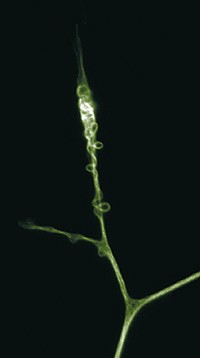Recoil and retract | Nature Reviews Neuroscience
- Select a language for the TTS:
- UK English Female
- UK English Male
- US English Female
- US English Male
- Australian Female
- Australian Male
- Language selected: (auto detect) - EN

Play all audios:

The authors used chick sensory neurons and exposed them to nitric oxide donors to elicit retraction. Morphologically, this type of axonal retraction closely resembles what is seen in vivo:
an enlarged distal region, a thin remnant and sinusoidal bends along the axon are observed. He et al. used quantitative immunofluorescence methods to determine whether there was a
significant decrease in the amount of microtubule polymer during this form of retraction, and found that there was no difference between control axons and those exposed to the nitric oxide
donor. Instead, they found that the microtubules formed coils that seemed to follow the contours of the sinusoidal bends of the shortening axon. Furthermore, they compared this observation
with the retraction that is seen in response to the microtubule-depolymerizing agent nocodazole. Morphologically, nocodazole-treated axons differed from those treated with nitric oxide: the
axonal shaft withered, and abnormal 'beads' and lateral extensions formed along its length. But more importantly, microtubules were not detected, indicating that the wholesale
depolymerization of tubulin is accompanied by a totally different axonal response. Last, He et al. tested whether axons treated with the microtubule-stabilizing agent taxol would retract in
response to nitric oxide. Indeed, the axons retracted, and they showed the same coiling and sinusoidal bundles that the authors had described previously.
He et al. propose that the coiling of microtubules depends on alterations in the activity of axonal motor proteins, the identities of which remain to be established. In more general terms,
it is interesting to compare retraction with elongation in the light of this study. Like axonal retraction, elongation was first proposed to depend strictly on tubulin polymerization, but
subsequent studies showed that tubulin polymers can be transported, 'ready made', down the axon by molecular motors. It would not be surprising if, similarly, retraction involves both
depolymerization and the reconfiguration of microtubules to achieve the precise wiring of the developing brain.
Anyone you share the following link with will be able to read this content: